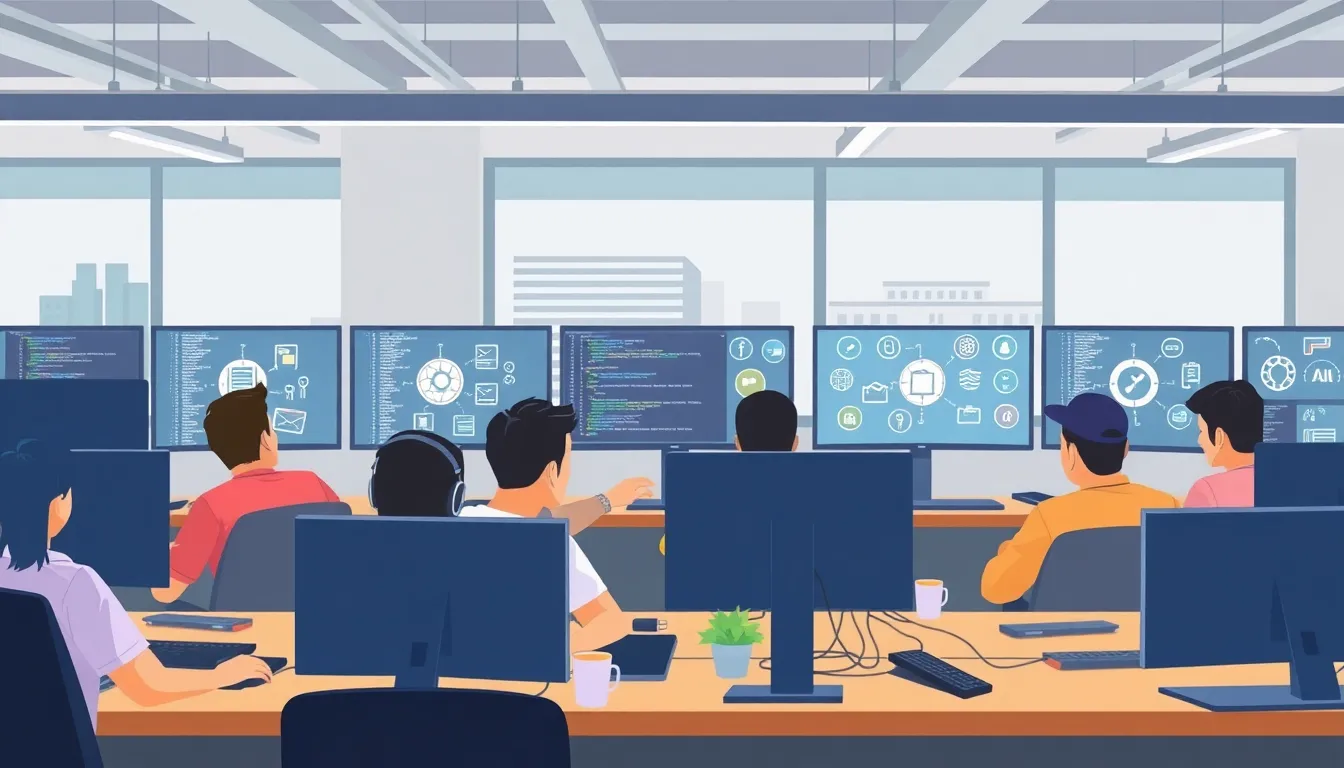In the bustling world of web development, the Philippines has emerged as a hidden gem. With a vibrant tech scene and a pool of talented developers, this tropical paradise is more than just a vacation spot. It’s a place where innovation meets creativity, and your website dreams can come to life faster than you can say “Mabuhay!”
Web Development Philippines
The web development sector in the Philippines showcases significant growth and potential. This growth emerges from a combination of a robust educational system and a burgeoning tech ecosystem. Developers in the Philippines consistently demonstrate technical skills across various programming languages and frameworks.
The country boasts a young and dynamic workforce. Many professionals possess degrees in computer science, IT, or related fields. Training programs and boot camps contribute to the continuous development of these skills, ensuring that the workforce stays updated with the latest industry trends.
Numerous companies, both local and international, recognize the value of outsourcing web development projects to the Philippines. Cost efficiency plays a crucial role, offering competitive pricing for high-quality work. This aspect attracts businesses seeking to maximize their budgets without compromising on quality.
Additionally, many Filipino developers express strong proficiency in English. Effective communication enhances collaboration between clients and developers, fostering a smoother workflow. This linguistic capability supports international projects, allowing seamless interactions with teams across the globe.
Accessibility to modern technology also influences the web development landscape. The Philippines has embraced advancements in tools and platforms that empower developers to create innovative solutions. This embrace of technology aligns with market demands, positioning the country as a formidable player in the global web development arena.
Overall, the combination of skilled talent, competitive pricing, and effective communication underpins the Philippines’ reputation as a growing hub for web development. These factors contribute to the ongoing success and expansion of the industry within the region.
Key Trends in Web Development

The web development landscape in the Philippines continues to evolve, driven by technology and a skilled workforce. Emerging technologies play a crucial role in this growth.
Emerging Technologies
Artificial intelligence (AI) and machine learning are gaining traction among Filipino developers. These technologies enable the automation of processes, enhancing user experiences. Blockchain technology sees increased interest for its secure data management capabilities. Additionally, progressive web applications (PWAs) offer offline access, making websites more user-friendly. Internet of Things (IoT) integration supports smart applications, connecting devices seamlessly. Filipino developers are quick to adopt these innovations, positioning themselves as tech-savvy professionals suited for diverse projects.
Popular Frameworks
React, Angular, and Vue.js dominate the framework choices among Filipino web developers. React’s flexibility allows efficient UI development, while Angular provides powerful features for building dynamic applications. Vue.js is favored for its simplicity and learning curve, appealing to new developers. PHP remains popular for backend development alongside Laravel, offering an elegant syntax and robust functionality. JavaScript is the backbone of many frameworks, supporting interactive features across platforms. Continued adoption of these frameworks ensures that Filipino developers remain competitive in the global market.
The Role of the Philippine Workforce
The Philippine workforce is a cornerstone of the country’s growing web development industry, characterized by its skilled developers and innovative spirit. Developers possess a range of technical abilities, deeply rooted in solid educational foundations.
Skill Sets and Education
Strong educational institutions in the Philippines offer degrees in computer science and IT, producing a talent pool that excels in various programming languages and frameworks. Graduates typically emerge with expertise in JavaScript, PHP, and Python, enabling them to tackle diverse projects. Continuous learning through training programs and boot camps keeps developers current with emerging technologies. Participation in these initiatives enhances their proficiency in frameworks like React, Angular, and Laravel. Educational emphasis on problem-solving and creative thinking further equips these professionals to thrive in a competitive job market.
Freelancers vs Agencies
Freelancers and agencies each play distinct roles in the web development landscape of the Philippines. Many freelancers offer flexibility, allowing businesses to hire talent for short-term projects. Agencies, on the other hand, provide comprehensive services with a team of professionals specializing in different areas of development. Both options deliver quality outcomes, with freelancers often being more budget-friendly, while agencies can handle larger-scale projects with structured processes. Collaboration between clients and these developers, whether freelancers or agency teams, facilitates effective communication and project success.
Benefits of Outsourcing to the Philippines
Outsourcing web development to the Philippines offers numerous advantages that enhance project efficiency. Cost efficiency stands out as a primary benefit. Companies enjoy competitive pricing yet receive high-quality work from skilled developers. A strong educational background supports Filipino developers, many of whom possess degrees in computer science and IT. This provides clients with confidence in their technical capabilities.
Communication flows smoothly due to widespread English proficiency. Filipino developers excel in understanding project requirements and collaborating effectively with international teams. Modern technology access further empowers these professionals, enabling them to deliver innovative solutions quickly. Adaptability and a willingness to embrace new technologies significantly contribute to successful project outcomes.
Cultural compatibility complements technological skills. Much of the workforce understands Western culture, which facilitates smoother interactions with international clients. Companies gain flexibility when working with freelancers for short-term projects. Agencies, on the other hand, offer comprehensive services with specialized teams for larger-scale initiatives.
Emerging technologies like artificial intelligence, machine learning, and blockchain increasingly play a pivotal role in Filipino web development. Incorporating these technologies enhances user experiences and improves data security. Popular frameworks such as React, Angular, and Vue.js dominate frontend development, while PHP and Laravel lead backend solutions.
Overall, the intersection of skilled talent, cost advantages, and seamless communication positions the Philippines as an ideal outsourcing destination for web development. These factors together foster a thriving environment where innovative ideas come to life, making it a strategic choice for companies worldwide.
Challenges in Web Development
Web development in the Philippines faces several obstacles that can impact project outcomes and market growth.
Technical Limitations
Developers often encounter challenges with infrastructure and connectivity. Many rural areas lack reliable internet access, which hinders remote work and collaboration. Limited access to cutting-edge technology can also restrict developers’ capabilities. Some professionals may not have exposure to the latest tools and frameworks. Additionally, platform performance issues can arise due to varying hardware capabilities. Ensuring compatibility with different devices and browsers remains an ongoing concern. Addressing these limitations is essential for maintaining a competitive edge in international markets.
Competition and Market Saturation
Growing competition in the web development sector can dilute opportunities for individual developers and agencies. An influx of new entrants creates a crowded market, making it difficult for companies to distinguish themselves. Pricing pressures often mount as various businesses vie for attention, leading to reduced profit margins. Additionally, agencies may struggle to secure projects against lower-cost freelancers. Navigating this competitive landscape requires strong branding and a focus on unique services. Remaining adaptable to market trends also proves crucial for long-term success in the web development arena.
Conclusion
The Philippines stands out as a vibrant hub for web development, combining skilled talent with innovative solutions. Its unique blend of cost efficiency and high-quality output makes it a preferred choice for companies seeking to outsource their projects.
With a strong educational foundation and a commitment to continuous learning, Filipino developers are well-equipped to tackle complex challenges. As the industry evolves, the adoption of emerging technologies further enhances their capabilities.
Despite facing challenges like infrastructure limitations and market saturation, the resilience and adaptability of the Filipino workforce position the country as a key player in the global web development landscape. Embracing these opportunities will ensure continued growth and success for both developers and businesses alike.

